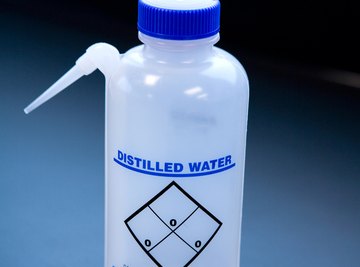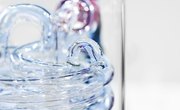
Valuable natural substances often occur as mixtures that contain both desirable and undesirable components. For example, crude oil includes various types of hydrocarbons that are suitable for different fuel applications, ocean water has a high salt content and iron ore contains mineral impurities in addition to usable iron. Over the centuries, people have developed numerous ways of refining or purifying natural materials. Simple distillation and fractional distillation are two variations on a basic technique for separating different components of a liquid.
Vapors and Evaporation
The relationship between temperature and evaporation is essential to understanding both simple and fractional distillation. When a liquid is in an open container, the atmosphere exerts a downward pressure on the surface of the liquid. This atmospheric pressure counteracts the liquid's vapor pressure, which is created by the kinetic energy of molecules that are evaporating from the surface of the liquid. As the temperature of the liquid increases, the average molecular kinetic energy also increases; more molecules evaporate, leading to higher vapor pressure. Boiling occurs when molecules can evaporate freely because the liquid has reached a temperature at which the vapor pressure equals the atmospheric pressure.
Simple Separation
Different compounds have different boiling temperatures. Similarly, at any given temperature, different compounds will have different vapor pressures. If a liquid mixture of different compounds is heated in an enclosed container, the composition of the vapor trapped above the liquid will reflect these differences. The vapor will contain more molecules of compounds with higher vapor pressure and fewer molecules of compounds with lower vapor pressure. A compound with a very high boiling temperature relative to the other compounds in the mixture will be nearly absent from the vapor, and non-volatile dissolved solids, such as salt, will remain as sediment in the heated container. Simple distillation is the process of collecting this vapor and cooling it so that it condenses back into a liquid. Simple distillation separates the components of a liquid mixture because the condensed liquid contains a higher proportion of compounds with higher vapor pressure and the original liquid contains a higher proportion of compounds with lower vapor pressure.
Distillation Dilemma
One simple distillation changes the proportion of compounds in the two final liquids, but it does not achieve complete separation. The process can be repeated to achieve progressively higher degrees of separation, but this is also wasteful because during each distillation procedure, some molecules escape into the atmosphere and some remain as residue in the distilling equipment. Fractional distillation addresses this dilemma -- improving on simple distillation by achieving higher degrees of separation in only one distillation procedure.
One Column, Multiple Evaporations
The primary difference between fractional distillation and simple distillation is the addition of a fractionating column between the heated container and the place where the vapor condenses. This column is filled with materials, such as thin metal wires or glass beads, that encourage condensation because they have high surface area. As the vapors rise through the fractionating column, they condense into liquid on the cooler surfaces of these materials. Hot vapors rising from below then cause this liquid to evaporate, then it condenses again, then it evaporates again and so forth. Each evaporation results in vapor with a higher proportion of molecules with higher vapor pressure. Thus, fractional distillation achieves superior separation with less material loss because one procedure is equivalent to multiple rounds of simple distillation.
References
About the Author
Joseph West has been writing about engineering, agriculture and religion since 2006. He is actively involved in the science and practice of sustainable agriculture and now writes primarily on these topics. He completed his copy-editing certificate in 2009 and holds a Bachelor of Science degree from the University of California-San Diego.
Photo Credits
Jupiterimages/Photos.com/Getty Images
